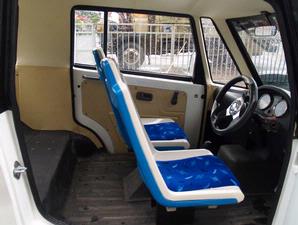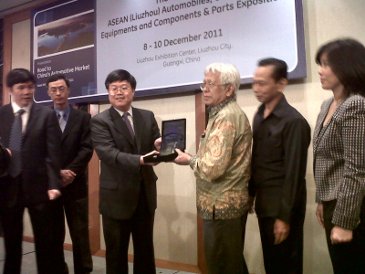 |
| Prototipe interior UPV |
JAKARTA, KOMPAS.com - Indonesia obsession of making cars affordable to the public at a price below was no less intense with Ratan Tata from India who have made the Tata Nano. If the Nano that has been horrendous world-sold with a base price 1 lakh or 100,000 rupees to Rp 21 million, people of Indonesia want to make small cars alias microcar with a target price of USD 30 million the most expensive.
That was delivered by Widya Aryadi, a young lecturer who had a lot of creative and auto discovery of the State University of Semarang (Unnes), Monday (18 / 5). Now, a coalition with Mufid Muhammad Anis, he founded Arina Motors Development in Semarang, Central Java, to fulfill his desire, make a microcar or small car. The car was born from the mind and the original creativity of the nation of Indonesia.
More Tiny. Thus was born the prototype micro-car designed for city people. Widya call UPV or Urban Personal Vehicle. With the support of the Regional Government of Central Java, this car was exhibited at the event Exhibition Production Indonesia (PPI) in 2009 organized the Department of Industry, last week (13-17 May).
Apparently, the appearance and the concept that this UPV offered Widya on attracting visitors. The proof, he received orders from the outside. "Actually we receive 300 units of the Netherlands. However, it can not be met because of the limitations of current conditions, "said Anis.
Meanwhile, according to Widya, some businessmen from China was curious to see this car. The reason is, "In China, a new small car in the form of three wheels. If we have four wheels," he said. In addition, the original design of this car and not a "copy paste".
The dimensions of this car is very tiny. Smaller than the Nano that has a length of 3.1 meters. UPV this dimension: length 2.05 meters, 1.15 meters wide, 1.6 meters high, 1.75 meter wheelbase, with a total weight of 400 kg prototype. "When finished, the target of 300 kg," said Widya.
The first prototype uses two large side doors. The size is 1.2 meters wide the door.Therefore, when opened, the entire interior clearly visible.
Economical. As a means of urban transport motorcycle replacement, using the machine Viar, 150 cc, SOHC, and producing power 9PS, according to Widya, UPV fuel consumption could reach 40 km per liter. "The BBC says, this car is more efficient than a motorcycle," he said citing the BBC crew commentary.
Amazingly, the BBC makes a special coverage on this car. Told, British television has been preparing its own scenario, the family who had many children live in a narrow alley.
"Well, by using the UPV, they got busy-busy. It's safer than the cramped ride motorcycles, "he said. Precisely, this UPV Indonesia humanize humans are only able to buy a motorcycle.
"Take the bike with another family member is very dangerous. In addition, if the rain, had to find shelter. With vehicles like these UPV, the condition can be prevented. It's safer for most families in Indonesia are only able to buy a motorcycle, "he said.
He adds, do not expect the UPV like the cars on the market in Indonesia today. "It's for those who already can afford!" He said.
Tests. Though still the first prototype stage, was invited KOMPAS.com Widya UPV this ride as a passenger to try around the arena Jakarta Fair. Apparently, the car is moving swiftly and fairly stable.
Convenience is also relatively good. Only, he looks a little trouble doing the gearshift.Dashboard is very simple and is taken from the motor. Suspension, double wishbone wear self-made from pipes and mencotek of Mini Mitsubishi Colt.
Quite interestingly, with only 1.2 meters wide, the UPV is so easy to pass through narrow spaces. In fact, when loaded into a truck to go back to Semarang, the car is easily glide on the porch of the building bari PRJ. Meaning, its ability to infiltrate the same as a motorcycle or three-wheeled Bajaj.
Conclusion. The interior was quite relieved. But, of course, still many shortcomings. For example in front of the front passenger. Leg selonjor less free. Apparently, the gas tank capacity 15 liters were placed. "Later moved," he said.
Seats are still fiberglass, static, and can not be set. The control system on the steering wheel and dashboard are still using this bike. "This is still far from standard conditions like we wanted," said Widya again. Car body is made of 0.8 mm plate so that its weight so heavy.
The second version, which is better and will be exhibited in IIMS (Indonesia International Motor Show) in July and August, the body is made of fiberglass. Also equipped with a back door or the third. "In this way can be used for trade," please Widya.
